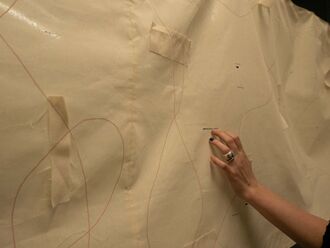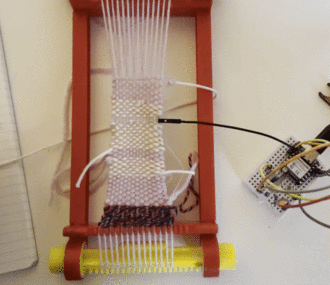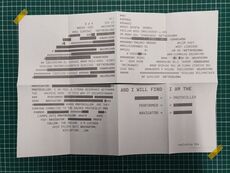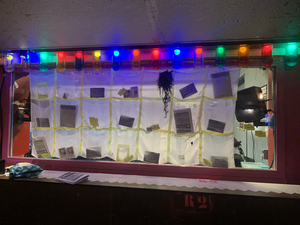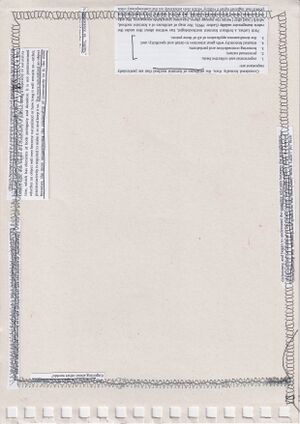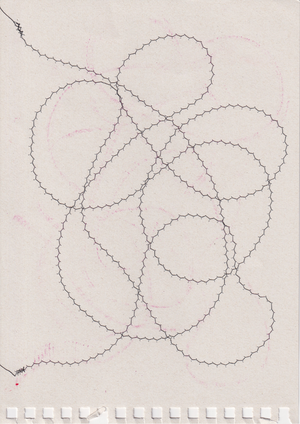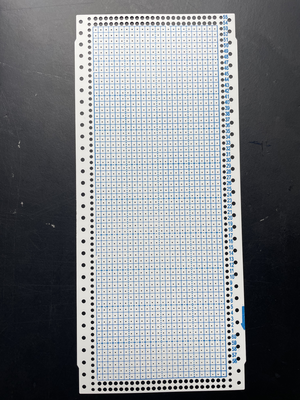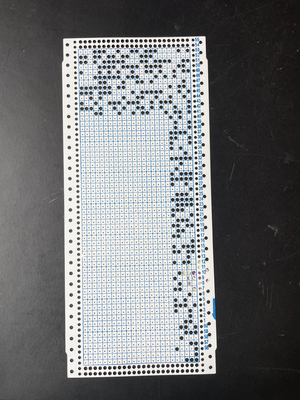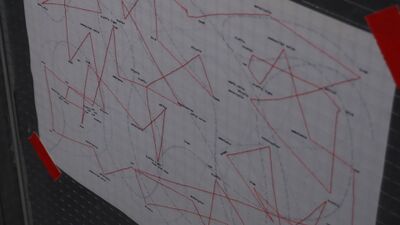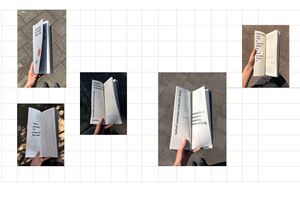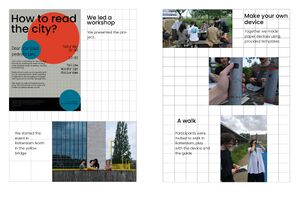AnitaProjectproposalSteveSuggests
Steve's suggested edits in colour or bold I I have very few actually). The proposal provides us with a very good basis for a discussion when the assessment rolls around, it is very clear about what and why you want to make this project, and you are equally clear about how it relates to your earlier work, and the context to which it is related.The illustrations also help clarify your position.
“Sound is pervasive, it spreads out in a space, connecting all bodies that it encounters. It is not an object or an attribute of an object but is generated by the reciprocal relationship between context object and subjects.” Elena Biserna in Walking, Listening and Soundmaking
bleep bloop
What do you want to make?
For the graduation project, I want to make a large scale textile soundboard (made as an interactive textile), containing a series of noises collected from public spaces, more specifically squares. This is because the squares form, place and function have historically (and still today) contributed to the urban development and feel of the city.
The instrument can be played to create different public soundscapes, inviting the person interacting with it to listen, move and imagine a path. Different points produce different sounds caught in the city. The person playing has to move and 'perform' a distinct choreography each time because of the distance between the triggers playing the sounds, enhancing the physicality and embodying the soundscape.
Playing allows the userto let go of expectations and predictability, enhances chances and small changes, and helps notice things from another perspective. I would like the 'player' to take away from the experience, the notion that city soundscapes are really worth listening to, they are so rich in information and contradistinct from one another, adding a layer to the definition of public space itself.
The fibers used for the production of the soundboard will partly be sourced from the squares where the listening and capturing of the sounds will occur. They will be washed, taken apart (perhaps dyed) and re-spun (by me) into yarn. This will be done to create a stronger connection to where the sounds originate from. The rest of the fibers used will be natural (wool), because of its specific soft and inviting texture.
Why do you want to make it?
Sound connects. It is not physical but exists so powerfully in space. It identifies places so distinctively but is not usually thought of or used to describe one other than ‘noisy’ or ‘silent’. Imagining and playing with mundane sounds, exploring the urban landscape with no visual aid, to notice and create new imaginary paths. Re-publishing existing and real-life 'boring' common sounds. Every time someone plays with the project, it will have a unique quality to it. The player will likely not be able to repeat the sequence of sounds, making the soundscape so subjective depending on the performer, much like the sound of the city. Listening is something so important to me, and I would like for this project to turn players into 'listeners'. It is an invitation to notice these differences in the city soundscape, the small tone changes and how sequences of sound vary each time they happen.
Fabric, like sound, is so textured. It invokes memories, feelings and is such a malleable and ever changing material. It is flexible and can adapt and bounce around its surroundings like a liquid, or like sound itself. Like city noise, its texture is so ordinary that it becomes almost invisible.
Another really important part of the piece to me, is the process of making it itself, spending time in squares, observing and listening to their dynamics. Collecting discarded fibers (e.g. a single glove), and collecting 'discarded' sounds. Making my own sensors with these materials from scratch. Manually spinning, knitting and weaving all of this material to bring it together again, in another form.
How do you plan to make it?
To be able to create this soundboard, I have identified a few crucial development elements: Learn how to make my own conductive yarn, spin test yarn with different concentrations of metal and test them out on smaller circuits. Collect fibers, wash and re-spin them into yarn that I will use for the textile.
Collect sounds, and fibers from squares in Rotterdam. This will be done by using a series of different listening methods, experiments and exercises I will come about during the development of the project. These methods will be documented and explained in the thesis, and they will set the tone for playful listening.
Design and test an 'interface' for the textile, decide the spacing between the sensors on a prototype circuit, have many people dance to it.
Work on small experiments of patches as well as installation shapes to test touch and find what people are drawn to interact and really play with.
What is your timetable?
October - recording, collecting and listening, drawing circuits, read more on interactive textiles, prepare for public moment and source materials needed for interactive textiles (yarn). Learn intarsia knitting.
November - recording, collecting and listening, test spin conductive yarn, do smaller projects involving woven (and knitted) circuits. Public moment tests and adaptations, coloquim with Michel (another testing opportunity), finalize proposal.
December - recording, collecting and listening, experiment with circuit connections, weaving circuits
January - recording, collecting and listening. Test distances between sensors (outside of the fabric) with larger groups, observe the choreographies people perform while playing. Start testing with woven (or knitted) samples.
February - recording, collecting and listening. Start selecting which sounds to use and why. Experiment with sounds on the sensors (in their skeleton form before they are integrated in the fabric)
March - recording, collecting and listening. Sound editing, making adjustments and playing with the music/instrument. Experiments with overlays, pitch adaptations, 'cheat codes' of combinations of pressing spots that will allow for sound manipulations to happen.
April - Finish preparing all materials for the final fabric. Spin yarn, finish the circuit and code, see what is missing for the piece and collect everything
May - Making the final fabric! And troubleshooting
June - Troubleshooting, graduation show, collective publication
Who can help you and how?
Research and Resources Tutors, classmates and supervisor, by discussing the ideas, reading each others work and talking about research area, many references and recommendation come up, especially from areas that I have yet to look into, or quite far from my research but with overlaps in some way. This also counts for resources, sourcing and machines that I could potentially use for production.
Listening and recording People that i will encounter while listening in public space, maybe sharing personal listening stories and observations.
Prototyping the circuit + code Joseph and Manetta, the people from interaction station, workshops on wearables and interactive textiles, and possibly individuals still to be contacted with interactive textile experience like Wendy Van Wynsberghe, Anja Hertenberger and maybe more:)
Weaving (or knitting) the piece Tutors at the fabric station, by giving advice on techniques, methods and materials that would help in the construction. Station skills at the fabric station.
Testing My classmates and people around the studio. Guests at public moments, and (hopefully) also interested people I will encounter while in public space.
Relation to previous practice
I feel very connected to both listening and traditional garment construction techniques. Working with textiles is something that has been present again and again in my practice.
Before starting Xpub, I studied Industrial Product Design, and I focused on designing and producing soft objects out of fabric and paper. I also worked in a fashion Atelier for 6 months, mainly producing prints and patterns for textiles, sewing by hand and working with a mixture of delicate soft materials, metal and mylar to create sculptural garments.
In Special Issue 22, I worked on the 'curtain', a sewn modular archive as an element to 'safekeep' and protect the different projects, sounds and survival tools that were created for the SI. I also focused a lot on field recording, exploring sound in public space and interactive radio making (with Hitchikers Guide to an Active Archive with Thijs and Rosa).
In Special Issue 23, I was really inspired to work with word/sentence manipulation, connecting it with sewing and quilting. I made experiments with sewing on paper, trying to create a very literal word quilt. I wanted to try to show the 'infrastructure' of my thoughts while reading and annotating these texts in a visual way, incorporating the seams metaphor quite literally. I tried to connect ideas from different texts by making a sewn collage.
In Special Issue 24, I worked with a very similar research topic to what I will be looking into in the graduation project and thesis, focusing on listening in public space, using textiles and paper to translate the sound. I worked on 'Knitting City Noise' a work in progress that focused on static listening, from one fixed point of view by using a sound sensor in Marconi Plein. From that, the sensor recorder yes sound or no sound based on the loudness around it. I then translated this nominal data to a punch card for knitting and am currently knitting it.
I also recorded sound while moving, in a series of walks, runs and cycles around Rotterdam. I then listened back and wrote down all the sounds I heard as a list, screen printed them onto cotton and sewed the paths of the recordings creating a subjective sound map of the city.
I also worked on 'Scripts to read the City' with Mania, a publication containing a series of scripts to look and listen in public space. The project imagines an urban environment that can be read, analyzed and criticized as a text. By reading the city in this way we find other possible ways of seeing, moving and listening. In a scripted city, marked by escalating levels of perfection, efficiency and control, the emancipatory aspects of urban life are undermined, allowing little room for anything that doesn't fit the image of the "norm".
Scripts to Read the City is an attempt to foster diverse experiences and uses of space, similar to a theater script interpreted differently by each actor. The tools of navigation are a device indicating which character to play and a guide, including a set of directions and instructions.
The project explores a relation between scripts and spontaneity, chance and control, and how scripts and unpredictability can enhance each other, stimulating imagination, encouraging us to engage with space from another perspective.
We also held a workshop based on the publication at SIGN in Groningen as a part of Spread Zinefest.
Relation to a larger context
The project will build on research surrounding the practices of soundwalking and deep listening, starting from defining listening and hearing as two very distinct things. In 'Deep Listening' Oliveros observes how listening is an active practice, a fully conscious choice, whereas hearing is simply something involuntary.
References/bibliography
Deep Listening: A Composer's Sound Practice, Pauline Oliveros
Walking, Listening and Soundmaking, Elena Biserna
Basta Now: women, trans & non-binary in experimental music Fanny Chiarello
Listening: A research method in art and Design, edited by Alice Twemlow
==Steve's comments on thesis outline==
Introduction
Sound connects. Sound creates friction. Sound frees from control. Sound passes through. Sound is not physical but exists so powerfully in space. It identifies places so strongly but is not usually thought of, or used to describe one, other than ‘noisy’ or ‘silent’. When thinking about what you hear when you are in public space, it is quite rare for a sound to be noticed if it fits into the expected range of common, 'boring' and mundane.
In this essay, I want to provide the reader with methods, exercises, experiments and listening techniques, and issue an invitation to listen, truly listen, and not just hear. In 'Deep Listening' Pauline Oliveros highlights the difference between listening and hearing. Listening requires attention, whereas hearing is simply the perception of sound waves received by the human ear. Oliveros highlights how she observed musicians were not listening, but hearing their own performances, creating a "disconnection from the environment". I notice that this is also the case when in public space. Whether you might be sitting, walking or cycling, all the sound around you is something that just falls into the background, to which not much attention is payed.
We will explore the urban landscape with no visual aid, noticing new imaginary sonic paths and composing new ones ourselves.
Do you listen or do you hear?
In this chapter, I would like to look into what listening and soundwalking means to me, in a very personal way, to then open into other listening and soundwalking practices like 'Deep Listening' (Pauline Oliveros), 'LISTEN' (Max Neuhaus), 'Inaudible Cities' (Jacek Smolicki) and more. I also plan to outline why listening to the city soundscape in particular is so important, to invite the reader to notice sounds that screams, as well as sounds hiding in little nooks and crannies, diving into the subjectivity of listening.
Time for listening
This chapter will contain methods, exercises and experiments that will made through the development of the text in order to help in listening carefully. It will 'activate' the research explored in the first chapter by showing how I will implement some of the examples into my own listening practice, as well as illustrate and propose exercises (that I will also carry out) for the reader to perform. I would like to include some space for city soundscape composition for the reader in the text, as a sort of guided soundwalk. To me, this chapter is the heart of the thesis as it advances methods for listening in public space and invites to implement them.
Caught Sounds
Observations on the sounds encountered during the research period (stemming from the 'Time for listening' chapter). I would like to include samples of sounds in the text, both in an auditory and written capacity. I would also like to issue an invitation for the reader to write down their observations inside of the body of this chapter as well. A reflection on the small differences and changes noticed, depending on the listening session, for example, does the exercise being performed affect what i hear?
References
Deep Listening A Composer's Sound Practice, Pauline Oliveros
Walking, Listening and Soundmaking, Elena Biserna
Walking from scores, Elena Biserna
LISTEN, Max Neuhaus
Inaudible Cities, Jacek Smolicki
Listening: A Research Method in Art & Design, edited by Alice Twemlow
Basta Now: women, trans & non-binary in experimental music, Fanny Chiarello
Smooth City, Renè Boer
The rest is noise, Alex Ross
Scratch Music, Cornelius Cardew

